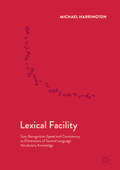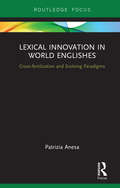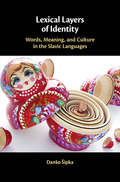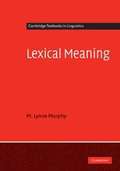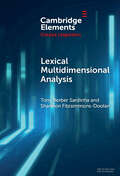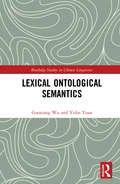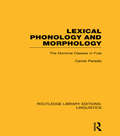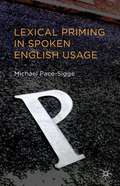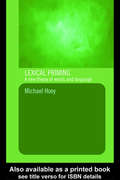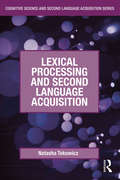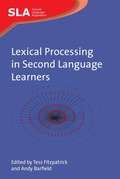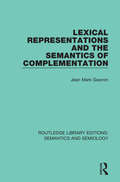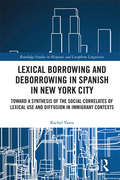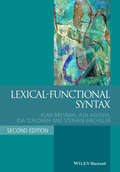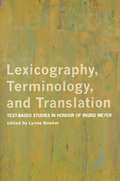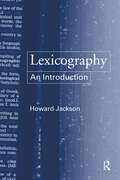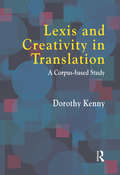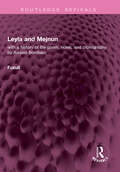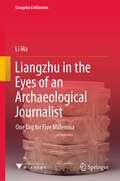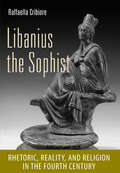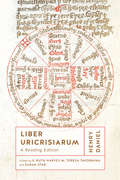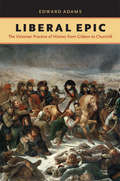- Table View
- List View
Lexical Facility
by Michael HarringtonThis book examines the simultaneous contribution of learner vocabulary size and speed to second language performance differences across learner levels and settings. Harrington considers vocabulary size and speed, as reflected in retrieval speed and consistency, as a three-dimensional measurement construct termed lexical facility. While size and retrieval speed are generally known, this is the first attempt to incorporate consistency, as measured by the coefficient of variation, as an index of vocabulary skill. Part 1 describes the three dimensions and the roles they play on lower level text processing and thus on second language performance more generally. Part 2 reports on seven studies and related research that investigate the sensitivity of the three dimensions, both individually and in combination, to proficiency differences in common domains of academic English performance. Harrington's framework and the theoretical and methodological issues that arise are presented in a manner accessible to a wide readership, including second language acquisition vocabulary researchers, testing and assessment practitioners, and those interested in second language research methodology.
Lexical Innovation in World Englishes: Cross-fertilization and Evolving Paradigms (Routledge Focus on Linguistics)
by Patrizia AnesaLexical Innovation in World Englishes contributes to the investigation of World Englishes by offering insights into the lexical developments of selected English varieties and their cross-fertilization potential. Taking a theoretical and empirical approach and focusing on neological formations, this book: discusses and problematizes different categorizations of English varieties and processes of word formation, considering the expansion of English across the world; draws on authentic examples taken from language corpora to gain a finer understanding of the varieties’ transformations and of their reciprocal influences from a lexical perspective; aims to validate general considerations on the lexical features of these varieties of English and test them using corpora. Including eight empirical case studies, this innovative text shows the importance of investigating lexical developments to observe the evolution of a variety while arguing for the need to go beyond a purely structuralist approach and to include a broader discursive and sociological perspective. Lexical Innovation in World Englishes is key reading for postgraduate students and researchers in the fields of World Englishes and language varieties.
Lexical Layers of Identity: Words, Meaning, and Culture in the Slavic Languages
by Danko ŠipkaFocusing on Slavic languages, Danko Šipka provides a systematic approach to lexical indicators of cultural identity. In contrast to existing research, which focuses heavily on syntactic and phonological approaches, Šipka's approach is novel, more systematic and encompassing, and postulates three lexical layers of cultural identity: deep, exchange, and surface. The deep layer pertains to culture-specific words, divisions, and features that are generally not subject to change and intervention. The exchange layer includes lexical markers of cultural influences resulting from lexical borrowing, which situates the speakers into various cultural circles. This layer is subject to gradual changes and some limited level of intervention from linguistic elites is possible. Finally, the surface layer encompasses the processes and consequences of lexical planning. It is subject to abrupt changes and it is shaped in constant negotiation between linguistic elites and general body of speakers.
Lexical Meaning
by M. Lynne Murphy"The ideal introduction for students of semantics, Lexical Meaning fills the gap left by more general semantics textbooks, providing the teacher and the student with insights into word meaning beyond the traditional overviews of lexical relations. The book explores the relationship between word meanings and syntax and semantics more generally. It provides a balanced overview of the main theoretical approaches, along with a lucid explanation of their relative strengths and weaknesses. After covering the main topics in lexical meaning, such as polysemy and sense relations, the textbook surveys the types of meanings represented by different word classes. It explains abstract concepts in clear language, using a wide range of examples, and includes linguistic puzzles in each chapter to encourage the student to practise using the concepts. 'Adopt-a-Word' exercises give students the chance to research a particular word, building a portfolio of specialist work on a single word"--
Lexical Multidimensional Analysis: Identifying Discourses and Ideologies (Elements in Corpus Linguistics)
by Tony Berber Sardinha Shannon Fitzsimmons-DoolanLexical Multidimensional Analysis (LMDA), an extension of Biber's (1988) Multidimensional Analysis, seeks to identify dimensions (correlated lexical features across texts in a corpus) unveiling underlying patterns of lexical co-occurrence and variation within texts that are operationalized as a variety of latent, macro-level discursive constructs. Initially developed in the 2010s, LMDA has been applied to diverse domains, including education policy, national representations, applied linguistics, music, the infodemic, religion, sustainability, and literary style. This Element introduces LMDA for the identification and analysis of discourses and ideologies, offering insights into how lexis marks discourse formations and ideological alignments. Two case studies demonstrate the application of LMDA: uncovering discourses on climate change within conservative social media and analyzing ideological discourses in migrant education.
Lexical Ontological Semantics (Routledge Studies in Chinese Linguistics)
by Guoxiang Wu Yulin YuanLexical Ontological Semantics introduces ontological methods into lexical semantic studies with the aim of giving impetus to various fields of endeavours which envision and model the semantic network of a language. Lexical ontological semantics (LOS) provides a cognition-based computation-oriented framework in which nouns and predicates are described in terms of their semantic knowledge and models the mechanism in which the noun system is coupled with the predicate system. It expands the scope of lexical semantics, updates methodologies to semantic representation, guides the construction of semantic resources for natural language processing, and develops new theories for human-machine interactions and communications.
Lexical Phonology and Morphology: Linguistics: Lexical Phonology And Morphology (Routledge Library Editions: Linguistics)
by Carole ParadisThis book presents a description of the phonology and morphology of the nominal class system in Fula, a dialect which displays 21 nominal classes. These are identified by suffixes, which can attach to nominal, verbal and adjectival stems. The main objective of this work is to show, through a lexical analysis, that there are only two monomorphemic marker variants, and that the distribution of these variants is predictable.
Lexical Priming In Spoken English Usage
by Michael Pace-SiggeThis book shows that over forty years of psychological laboratory-based research support the claims of the Lexical Priming Theory. It examines how Lexical Priming applies to the use of spoken English as the book provides evidence that Lexical Priming is found in everyday spoken conversations.
Lexical Priming: A New Theory of Words and Language
by Michael HoeyLexical Priming proposes a radical new theory of the lexicon, which amounts to a completely new theory of language based on how words are used in the real world. Here they are not confined to the definitions given to them in dictionaries but instead interact with other words in common patterns of use. Using concrete statistical evidence from a corpus of newspaper English, but also referring to travel writing and literary text, the author argues that words are 'primed' for use through our experience with them, so that everything we know about a word is a product of our encounters with it. This knowledge explains how speakers of a language succeed in being fluent, creative and natural.
Lexical Processing and Second Language Acquisition (Cognitive Science and Second Language Acquisition Series)
by Natasha TokowiczLexical Processing and Second Language Acquisition provides a comprehensive overview of research on second language lexical processing, integrating converging research and perspectives from Cognitive Science and Second Language Acquisition. The book begins by introducing the dominant issues addressed by research in the field in cognitive science and discussing the relevant models in the literature. It later moves toward exploring the different factors that impact second language lexical processing as well as cognitive neuroscientific approaches to the study of the issues discussed throughout the book. A concluding chapter offers a global summary of the key issues and research strands, in addition to directions for future research, with a list of recommended readings providing students and researchers with avenues for further study.
Lexical Processing in Second Language Learners
by Tess Fitzpatrick Andy BarfieldThis book presents studies from authors at the cutting edge of second language vocabulary research, whose output represents much of the current focus and direction of work in this area. The authors address various aspects of L2 lexical processing and explore different models of acquisition, processing and storage. The studies are linked by the fact that the authors have all belonged to the same dynamic and influential vocabulary acquisition research group led by Paul Meara. Alison Wray provides an overview of how Meara has led this group's research activities in an innovative PhD programme, and John Read and Paul Nation contribute a critical evaluation of Meara's wide-ranging contributions to the field of vocabulary acquisition research. The research studies presented here are relevant and replicable, offering researchers and teachers many valuable and critical insights into lexical processing in second language learners.
Lexical Representations and the Semantics of Complementation (Routledge Library Editions: Semantics and Semiology #6)
by Jean Mark GawronFirst published in 1983, this book represents an effort to lay the groundwork for a general approach to lexical semantics that pays heed to the needs of a theory of discourse interpretation, a theory of compositional semantics, and a theory of lexical rules. The first chapter proposes a basic framework in which to undertake lexical description and a lexical semantic analogue to the classical syntactic distinction between subcategorized for complement and adjunct. This apparatus for lexical description is expanded in the second chapter. A theory of the semantics of nuclear terms along with a proposed implementation is presented in chapter three. The fourth chapter argues that a number of regular, semantically governed valence alternations could be captured in frame representations that give rise to various kinds of realisation options. The final chapter examines interaction of these phenomena with a general account of prediction or control along with the general framework of lexical representation.
Lexical borrowing and deborrowing in Spanish in New York City: Towards a synthesis of the social correlates of lexical use and diffusion in immigrant contexts (Routledge Studies in Hispanic and Lusophone Linguistics)
by Rachel VarraLexical Borrowing and Deborrowing in Spanish in New York City provides a sociodemographic portrait of lexical borrowing in Spanish in New York City. The volume offers new and important insights into research on lexical borrowing. In particular, it presents empirical data obtained through quantitative analysis to answer the question of who is most likely to use English lexical borrowings while speaking Spanish, to address the impact that English has on Spanish as spoken in the city and to identify the social factors that contribute to language change. The book also provides an empirical, corpus-based-approach to distinguishing between borrowing and other contact phenomena, such as codeswitching, which will be of interest to scholars of language contact and bilingualism.
Lexical-Functional Grammar: An Introduction
by Kersti Börjars Rachel Nordlinger Louisa SadlerA clear introduction to lexical-functional grammar (LFG), this outstanding textbook sets out a formal approach to the study of language using a step-by-step approach and rich language data. Data from English and a range of other languages is used to illustrate the main concepts, allowing those students not accustomed to working with cross-linguistic data to familiarize themselves with the theory, while also enabling those interested in how the theory can account for more challenging data sets to extend their learning. Exercises ranging from simple technical questions to analyses of a data set, as well as a further resources section with a literature review complete each chapter. The book aims to equip readers with the skills to analyze new data sets and to begin to engage with the primary LFG literature.
Lexical-Functional Syntax (Blackwell Textbooks in Linguistics)
by Joan Bresnan Ash Asudeh Ida Toivonen Stephen WechslerLexical-Functional Syntax, 2nd Edition, the definitive text for Lexical Functional Grammar (LFG) with a focus on syntax, is updated to reflect recent developments in the field. Provides both an introduction to LFG and a synthesis of major theoretical developments in lexical-functional syntax over the past few decades Includes in-depth discussions of a large number of syntactic phenomena from typologically diverse languages Features extensive problem sets and solutions in each chapter to aid in self-study Incorporates reader feedback from the 1st Edition to correct errors and enhance clarity
Lexicography, Terminology, and Translation: Text-based Studies in Honour of Ingrid Meyer
by Lynne BowkerThis volume in honour of Ingrid Meyer is a tribute to her work in the interrelated fields of lexicography, terminology and translation. One key thing shared by these fields is that they all deal with text. Accordingly, the essays in this collection are united by the fact that they too are all "text-based" in some way. In the majority of essays, electronic corpora serve as the textual basis for investigations. Chapters focusing on electronic corpora include a description of a tool that can be used to help build specialized corpora in a semi-automatic fashion; corpus-based investigations of terminological knowledge patterns, terminological implantation, lexicographic information and translation solutions; comparisons of corpora to conventional resources such as dictionaries; and analyses of corpus processing tools such as translation memory systems. In several essays, notably those dealing with historical or literary documents, the texts in question are specific manuscripts that have been studied with a view to learning more about lexicographic and translation practice. The volume is rounded out with a chapter on audiovisual translation that takes a non-conventional view of text, where "text" includes film.
Lexicography: An Introduction
by Howard JacksonThis book is an accessible introduction to lexicography – the study of dictionaries.Dictionaries are used at home and at school, cited in law courts, sermons and parliament, and referred to by crossword addicts and Scrabble players alike. Lexicography provides a detailed overview of the history, types and content of these essential references. Howard Jackson analyzes a wide range of dictionaries, from those for native speakers to thematic dictionaries and those on CD-ROM, to reveal the ways in which dictionaries fulfil their dual function of describing the vocabulary of English and providing a useful and accessible reference resource.Beginning with an introduction to the terms used in lexicology to describe words and vocabulary, and offering summaries and suggestions for further reading, Lexicography: An Introduction is highly student-friendly. It is ideal for anyone with an interest in the development and use of dictionaries.
Lexie the Word Wrangler
by Rebecca Van SlykeThis clever celebration of words and their meanings features a strong cowgirl who wrangles words alongside cattle. Lexie is the best wrangler west of the Mississippi—word wrangler, that is. She watches over baby letters while they grow into words and ties shorter words together into longer ones; she herds words into sentences, hitches sentences together, and pens them all in to tell a story. But lately, something seems off at the ranch. First the d goes missing from her bandana, leaving her with a banana to tie around her neck, and soon afterward every S-T-A-R in the sky turns into R-A-T-S. There&’s no doubt about it—there&’s a word rustler causing this ruckus, and Lexie plans to track him down . . . even if it means riding her horse through the sticky icing of a desert that&’s suddenly become a giant dessert. This fantastic spin on &“cowboy&” stories populates Lexie&’s ranch with lively letters and words, alongside the typical cattle and horses, and stars a smart, confident, charismatic heroine. Rebecca Van Slyke&’s creative, silly wordplay pairs perfectly with Jessie Hartland&’s lively illustrations, and there&’s even a glossary of helpful terms for up-and-coming word wranglers.
Lexis and Creativity in Translation: A Corpus Based Approach
by Dorothy KennyComputers offer new perspectives in the study of language, allowing us to see phenomena that previously remained obscure because of the limitations of our vantage points. It is not uncommon for computers to be likened to the telescope, or microscope, in this respect. In this pioneering computer-assisted study of translation, Dorothy Kenny suggests another image, that of the kaleidoscope: playful changes of perspective using corpus-processing software allow textual patterns to come into focus and then recede again as others take their place. And against the background of repeated patterns in a corpus, creative uses of language gain a particular prominence. In Lexis and Creativity in Translation, Kenny monitors the translation of creative source-text word forms and collocations uncovered in a specially constructed German-English parallel corpus of literary texts. Using an abundance of examples, she reveals evidence of both normalization and ingenious creativity in translation. Her discussion of lexical creativity draws on insights from traditional morphology, structural semantics and, most notably, neo-Firthian corpus linguistics, suggesting that rumours of the demise of linguistics in translation studies are greatly exaggerated. Lexis and Creativity in Translation is essential reading for anyone interested in corpus linguistics and its impact so far on translation studies. The book also offers theoretical and practical guidance for researchers who wish to conduct their own corpus-based investigations of translation. No previous knowledge of German, corpus linguistics or computing is assumed.
Leyla and Mejnun: with a history of the poem, notes, and bibliography by Alessio Bombaci (Routledge Revivals)
by FuzuliFirst published in 1970, Leyla and Mejnun provides a thorough introduction to the Leyla and Mejnun love story and the various forms in which the story has appeared in the Islamic world. Finally, it offers for the delight of the English poetry lover, an extremely readable translation of the Turkish version of the story. This book will be of interest to students of literature and history.
Liangzhu in the Eyes of an Archaeological Journalist: One Dig for Five Millennia (Liangzhu Civilization)
by Li MaThis book traces archaeological exploration and discoveries as early as 2012 and reveals Liangzhu culture by reviewing seven years of archaeological findings at the Liangzhu historical site, developments in archaeology history, the psychological journeys of archaeologists, as well as the collision of schools of thought. It also contains in-depth interviews with archaeological experts and other specialists, building a bridge between popular interest and academic interest, and showcases Liangzhu civilization and archaeology for professionals and the general public alike.
Libanius the Sophist: Rhetoric, Reality, and Religion in the Fourth Century
by Raffaella CribioreLibanius of Antioch was a rhetorician of rare skill and eloquence. So renowned was he in the fourth century that his school of rhetoric in Roman Syria became among the most prestigious in the Eastern Empire. In this book, Raffaella Cribiore draws on her unique knowledge of the entire body of Libanius’s vast literary output—including 64 orations, 1,544 letters, and exercises for his students—to offer the fullest intellectual portrait yet of this remarkable figure whom John Chrystostom called “the sophist of the city."Libanius (314–ca. 393) lived at a time when Christianity was celebrating its triumph but paganism tried to resist. Although himself a pagan, Libanius cultivated friendships within Antioch’s Christian community and taught leaders of the Church including Chrysostom and Basil of Caesarea. Cribiore calls him a “gray pagan” who did not share the fanaticism of the Emperor Julian. Cribiore considers the role that a major intellectual of Libanius’s caliber played in this religiously diverse society and culture. When he wrote a letter or delivered an oration, who was he addressing and what did he hope to accomplish? One thing that stands out in Libanius’s speeches is the startling amount of invective against his enemies. How common was character assassination of this sort? What was the subtext to these speeches and how would they have been received? Adapted from the Townsend Lectures that Cribiore delivered at Cornell University in 2010, this book brilliantly restores Libanius to his rightful place in the rich and culturally complex world of Late Antiquity.
Libanius: A Critical Introduction
by Lieve Van HoofA professor of Greek rhetoric, frequent letter writer and influential social figure, Libanius (AD 314-393) is a key author for anybody interested in Late Antiquity, ancient rhetoric, ancient epistolography and ancient biography. Nevertheless, he remains understudied because it is such a daunting task to access his large and only partially translated oeuvre. This volume, which is the first comprehensive study of Libanius, offers a critical introduction to the man, his texts, their context and reception. Clear presentations of the orations, progymnasmata, declamations and letters unlock the corpus, and a survey of all available translations is provided. At the same time, the volume explores new interpretative approaches of the texts from a variety of angles. Written by a team of established as well as upcoming experts in the field, it substantially reassesses works such as the Autobiography, the Julianic speeches and letters, and Oration 30 For the Temples.
Liber Uricrisiarum: A Reading Edition
by Henry DanielHenry Daniel’s Liber Uricrisiarum is the earliest known work of academic medicine written in Middle English, presented here for the first time in a complete edition. Working in the late 1370s, Daniel combined authoritative medicine from written sources with his own personal experience, creating a text that stands out for its linguistic originality, intellectual scope, and wide circulation. Extant in over three dozen manuscript witnesses and two early modern print copies, Liber Uricrisiarum describes medieval humoral theory, anatomy, physiology, disease, medical astronomy, reproductive processes, and more, all within the broader context of uroscopic diagnosis. The introduction situates the text and its author in their medical, intellectual, linguistic, and bibliographic contexts, outlining the uroscopic tradition to which Daniel contributes, and describing the relationships among the many manuscripts containing the Liber Uricrisiarum. This edition presents the Middle English text, with a general glossary, glossary of proper names, and explanatory notes that explain obscure words and phrases and identify Daniel’s sources. It also includes the complete set of diagrams contained in the Royal manuscript; appendices providing the Latin and English versions of the prologue and epilogue; an extensive translation from one of Daniel’s important sources, Isaac Israeli’s De urinis; tables relevant to Daniel’s astronomical measurements; and an analysis of the Royal manuscript’s dialect. Cumulatively, the edition and apparatus introduce readers to an important yet understudied text, the details of which will have significant impact on studies of medieval medicine and science, intellectual history, and Middle English language and literature.
Liberal Epic: The Victorian Practice of History from Gibbon to Churchill (Victorian Literature and Culture Series)
by Edward AdamsIn Liberal Epic, Edward Adams examines the liberal imagination's centuries-long dependence on contradictory, and mutually constitutive, attitudes toward violent domination. Adams centers his ambitious analysis on a series of major epic poems, histories, and historical novels, including Dryden's Aeneid, Pope's Iliad, Gibbon's Decline and Fall of the Roman Empire, Byron's Don Juan, Scott's Life of Napoleon, Napier's History of the War in the Peninsula, Macaulay's History of England, Hardy's Dynasts, and Churchill's military histories--works that rank among the most important publishing events of the past three centuries yet that have seldom received critical attention relative to their importance. In recovering these neglected works and gathering them together as part of a self-conscious literary tradition here defined as liberal epic, Adams provides an archaeology that sheds light on contemporary issues such as the relation of liberalism to war, the tactics for sanitizing heroism, and the appeal of violence to supposedly humane readers. Victorian Literature and Culture Series
